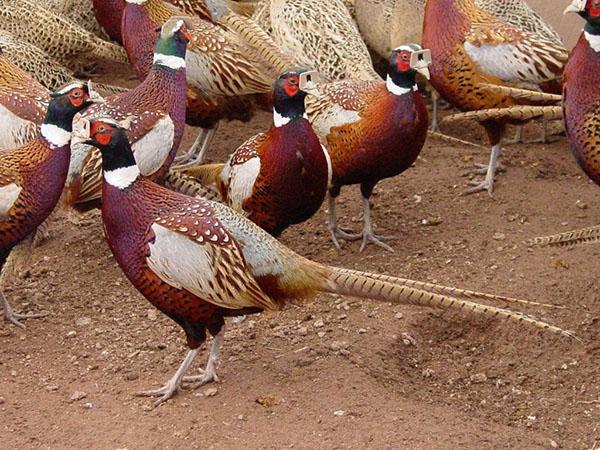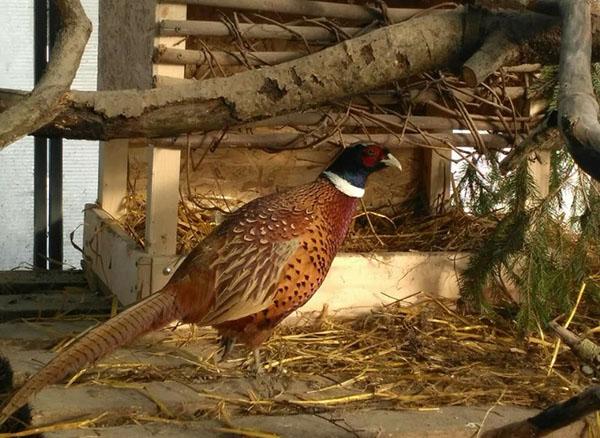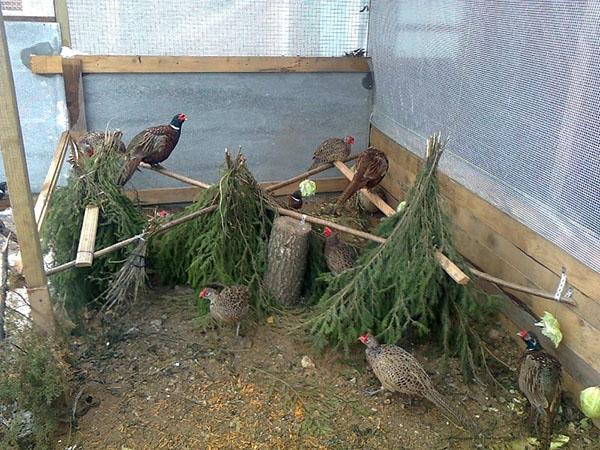Pheasants at home: types of breeds, rules of care
 Pheasants feel good at home and it is not very difficult to grow them. These are very beautiful birds, which are kept in private estates for decorative purposes. In farms, they can bring considerable profit, since the meat of this bird is used for food.
Pheasants feel good at home and it is not very difficult to grow them. These are very beautiful birds, which are kept in private estates for decorative purposes. In farms, they can bring considerable profit, since the meat of this bird is used for food.
Pheasants at home: breeding and keeping conditions

If the main task is to obtain meat, then the birds are kept in cages. If it is necessary to increase the population, it is better to keep it in free-range conditions.
The territory is covered with sand, the size is calculated as follows: for 1 bird - not less than 2 m2 in the building for sleeping and at least 10 m2 in an open-air cage. Fenced off with a metal mesh, be sure to cover with a "roof" made of nylon mesh. A shelter is needed so that the pheasants have a place to hide from the scorching sun or rain.
 In the bird pen, lay out branches, logs, a dry tree to simulate natural conditions. Arrange small "baths" of sand mixed with ashso that the pheasants clean themselves in them.
In the bird pen, lay out branches, logs, a dry tree to simulate natural conditions. Arrange small "baths" of sand mixed with ashso that the pheasants clean themselves in them.
The most popular breeds of pheasants for breeding:
- Diamond. The breed is originally from China. Outwardly, a very beautiful bird, so these pheasants are kept more for decorative purposes. They are demanding on the ambient temperature (below -250 C do not stand). They rarely grow more than 1 kg; fish oil and vitamins must be included in the diet. Egg production - up to 30 pieces.

- Gold. A beautiful decorative breed of birds. They give few eggs, up to 25 pieces, the weight is not large, about 1 kg. Poorly tolerate frost, at a temperature of -200 The birds die. They need to be fed not only with greens, but also with vitamins, be sure to add fish oil.

- Silver. The most popular pheasant species. They take root well in Russia. The birds of this weather have thick plumage, which protects them in frosts around -300 C. Birds are large, weighing 5 kg. Each of them brings 50 eggs per season.

The main condition for keeping pheasants is less noise on the site. Birds are incredibly shy in nature. Any abrupt changes in mode or if another person starts feeding them, the birds begin to lay fewer eggs. Pheasants do not need artificial lighting.
Winter and summer pheasant care
 The pheasant family is 1 male and 2 or 3 females, no more is needed, otherwise there will be fewer eggs, they will be unfertilized. From February to March, families of pheasants are kept in separate rooms. At this time, two males cannot be put in a common paddock, otherwise they will begin to arrange fights for females.
The pheasant family is 1 male and 2 or 3 females, no more is needed, otherwise there will be fewer eggs, they will be unfertilized. From February to March, families of pheasants are kept in separate rooms. At this time, two males cannot be put in a common paddock, otherwise they will begin to arrange fights for females.  After the breeding period, birds can be placed in a common pen.
After the breeding period, birds can be placed in a common pen.
The first flock of pheasant eggs can be incubated by a hen.
Females lay eggs for 2-2.5 months. Each weighs 30 g. The total number of eggs from one individual is up to 50 pieces. Eggs can be incubated by both a female pheasant and a regular chicken. It is quite suitable and hatching.
If it is planned to incubate eggs by female pheasants, then they need to equip the nests: it is enough to dig a small depression and put dry grass in it. You can use old baskets made of willow twigs for these purposes.
Feeding pheasants
 Pheasants are not capricious in terms of their diet.They will eat food typical for chickens: wet mash, as well as green food. Food consumption per bird per day is 100 g, per year it turns out to be 36-38 kg. Birds should have enough protein in their diet for good egg production and young birds gaining muscle weight quickly.
Pheasants are not capricious in terms of their diet.They will eat food typical for chickens: wet mash, as well as green food. Food consumption per bird per day is 100 g, per year it turns out to be 36-38 kg. Birds should have enough protein in their diet for good egg production and young birds gaining muscle weight quickly.
Pheasant food:
- Food for chicks. They are fed up to two months of age with ready-made feed for broilers or turkey poults: it contains 25-27% protein. Also, in the very first days, boiled eggs can be given to chicks, which are mixed with chopped herbs. Instead of water, milk whey is poured. Then they gradually transfer to compound feed for chickens... By the end of the first week, you can cook millet porridge. After 2 months, they feed in the same way as adults.
- Food for adult pheasants. Can be fed with compound feed or grain (barley, corn, wheat). The proportion of grain in the mixture is about 60%. Fresh vegetables, vitamin C and just a little sugar should be added. Crushed chalk and fish meal (10%) are added as a source of minerals. An important element of the diet is the addition of fish oil (up to 1%). Only cold water is poured into drinkers. There should be a lot of drinking bowls, as well as containers with feed, they are located under a canopy. To increase the percentage of fertilized eggs, antibiotics are mixed with food during the breeding season. It can be erythromycin or penicillin, biovit is also suitable. In winter, you need to add vitamins to increase the immunity of pheasants.
Pheasants will gladly eat Colorado potato beetles, and gain well in weight from these pests of potatoes.
Possible diseases
 Like any poultry, the pheasant can get sick. Therefore, it is important to observe their behavior, how readily they eat food.
Like any poultry, the pheasant can get sick. Therefore, it is important to observe their behavior, how readily they eat food.
When the first signs of illness appear, you should contact your veterinarian as soon as possible.
The main diseases of pheasants can be divided into three categories:
- Invasive. These include lice and scabies. The down-eater settles on the feathers of the bird; in the summer, almost all individuals are sick. To prevent them from pestering pheasants, it is necessary to equip them with sand baths. Mites provoke scabies. At the same time, the pheasant's head becomes bald, a limestone-like plaque forms. All wounds on the body of the bird must be treated with a neguven (concentration 0.15%). In extreme cases, for both lesions, pheasants are treated with insecticides.
- Non-communicable diseases. In this group, emphysema and dermatitis are most common. With emphysema, the air sac ruptures, the wings are tied to the bird, and its mobility is limited. In case of dermatitis, the body is covered with ulcers with a red crust. These inflammations are the result of injury to the skin. Places are treated with iodine, the dosage of vitamins in the diet is increased.
- Infectious diseases. Aspergillosis, laryngotracheitis and smallpox are three diseases that frequently affect pheasants. Aspergillosis provokes a fungus that settles on the lungs of the bird. Pheasants' paws and beak turn blue from it. They are treated with antifungal drugs. Lagingotracheitis requires laboratory confirmation; treatment should only be prescribed by a veterinarian. Its main symptom is a decrease in appetite, cough, poor egg production. Smallpox is a viral disease that leads to death. It manifests itself in the form of a rash on the skin, hoarseness, the bird eventually suffocates. Externally, they are treated with a solution of Lugol, antiviral agents are prescribed inside.
Breeding pheasants is a very profitable investment: in six months or a year, the money spent pays off. Their meat is very tasty, in demand among restaurateurs, some breeds are distinguished by high egg production. So far, not so many farms are engaged in breeding these birds. However, starting a business from scratch takes a lot of work.